Bulletin headline summary from RanSquawk
- DAX and FTSE at 1 month lows in sour risk tone as Trump issues USD 200bln tariff threat
- Tariff threats send the DXY to YTD high
- Looking ahead, highlights include, the Technical committee meeting between OPEC and non-OPEC members, ECB's Lane and Fed's Bullard
In response, China Mofcom said China will have to adopt comprehensive steps to fight back firmly and warned it will take qualitative and quantitative measures if US publishes additional tariff list; China also warned that it was preparing a second round of tariffs on US energy; US oil, gas and coal face 25% levy in threatened second round of duties.
While tough trade talk is nothing new for investors in 2018, a sense that stress is ratcheting up between the U.S. and China is clearly taking a toll on markets. The protectionist moves come at a time when many are already voicing concern that global growth could lose momentum, as it also contends with America's faster tightening of monetary policy and the end of European stimulus.
"What you saw at the start of the year was global synchronized growth," Emad Mostaque, co-chief investment officer at Capricorn Fund Managers, said in an interview on Bloomberg Television. "It was a cooperative game. Now, we're moving to a more competitive, negative-sum game."
In light of the escalating tit-for-tat trade war, which so far shows no signs of stopping, and to the contrary appears to be accelerating, S&P futures have fallen sharply throughout the session, while Dow futures are -340 points, with the cash index set for its 6th consecutive down day.
The MSCI index of Asia-Pacific shares outside Japan fell 1.9 percent to its lowest since early December. The losses intensified through the day as the rout deepened in China where the 3,000 support level in the Shanghai Composite finally gave way as Beijing's "National Team" plunge protectors failed to step in after Monday's holiday, resulting in the lowest close in nearly two years as the Shanghai Composite Index plunged 3.8%, its lowest since June 27, 2016, while Hong Kong's Hang Seng .HSI shed as much 3 percent before ending 2.8% down.
"Trump appears to be employing a similar tactic he used with North Korea, by blustering first in order to gain an advantage in negotiations," said Kota Hirayama, senior emerging markets economist at SMBC Nikko Securities in Tokyo.
"The problem is, such a tactic is unlikely to work with China."
Predictably, hardest hit were tech stocks which stand to suffer the most in any direct trade war, with Orient Securities, 360 Security Technology plunging by the 10% daily limit, while the tech heavy Shenzhen Composite index crashed -5.9%, while the ChiNext Index of small-cap and tech shares slumped 4.8%, to its lowest level in more than three years, and is now 61% below peak reached in June 2015. Not even the PBOC adding liquidity with 200BN MLF operation and net 50BN reverse repo injection helped boost sentiment.
"You only have to look at how far the main Shanghai index has fallen to see that people would probably want some safe-haven assets at this point," said DZ Bank analyst Andy Cossor. China had warned it will take "qualitative" and "quantitative" measures if the U.S. government publishes an additional list of tariffs on its products.
China's economy has already been clouded by a sharp slowdown in fixed asset investment growth due to the government's deleveraging drive, a problematic property sector, a mounting debt burden and rising credit defaults. Economists at Nomura wrote, "The rising risk of a disruptive trade conflict makes a bad situation tentatively worse."
Elsewhere, Japan's Nikkei lost 1.8%, South Korea's KOSPI dropped 1.3% while Australian stocks bucked the trend and added 0.1%, helped by a depreciating currency and an overnight bounce in commodity prices.
In Europe it was more of the same, with the Stoxx Europe 600 tumbling for a third day. The stock move in Europe was tempered by a weaker euro, however, which unlike its reaction to last week's trade jitters, promptly tumbled, wiping out all of Monday's gains. European mining stocks lead the Stoxx 600 Index down to touch lowest level since late-April; the export-heavy DAX underperformed, sliding 1.4% as automakers continue declines.
As usual, during times of stress and suring dollar, emerging markets were in turmoil as the implications of a possible trade war filter through to investors. Developing-nation stocks headed for the biggest drop since March, and currencies slid as the South African rand and Turkish lira led declines.
As one would expect, the safe haven US Dollar advanced across the board and pressured G-10 and EM counterparts, with the EUR/USD sliding below 1.1600 and GBP/USD falls below 1.3200; the Bloomberg Dollar Index, BBDXY, is now the highest it has been since April.
Meanwhile, as Chinese stocks crashed, the yuan hit a five-month low amid speculation that China may launch an aggressive FX devaluation in retaliation hence the scramble to frontrun the next major central bank move. The dollar wasn't the only safe haven: the Japanese Yen also strengthened 0.7% while commodity-currencies AUD and CAD underperform G-10 peers. The British pound was also under pressure as U.K. Prime Minister Theresa May prepares for another knife-edge Brexit vote on Wednesday. The Australian dollar, often seen as a proxy for China-related trades, brushed a one-year low of $0.7381.
But the big FX story was once again in EM currencies, which as shown below have been another sea of red as capital flight becomes a major concern for most of these nations which until recently were the happy recipients of excess dollar funding.
The rush for safety also manifested itself in the Treasury complex with US 10-year yields sliding as low as 2.85%, before settling three bps lower to 2.88% as T-note futures clear Friday's high. Elsewhere it was more of the same with Germany's 10-year yield dropped 4bps to 0.36%, the lowest in almost three weeks with its sixth straight decline; Bunds got further support from Draghi's Sintra speech which was similar to ECB meeting, and certainly not the fireworks from last year. Britain's 10-year yield dipped 5bps to 1.324 percent, reaching the lowest in almost three weeks on its sixth straight decline and the biggest decrease in three weeks, while Italy's 10-year yield dipped less than one basis point to 2.554%, hitting the lowest in more than two weeks.
Once again, the stress was highest in emerging markets, where the average yield on domestic currency debt was the highest since March 2017 and fast approaching 7%.
The Bloomberg Commodity Index fell 1% as crude, base metals and agriculture products slide in tandem.
With Russia and Saudi Arabia pushing for higher output, crude oil markets remained volatile ahead of Friday's OPEC meeting. Brent crude futures fell 0.8 percent to $74.76 a barrel after rallying 2.5% overnight, while U.S. light crude futures retreated 0.9 percent to $65.27. Lower-risk assets gained on the latest round of trade threats with spot gold up 0.35% at $1,282.26 an ounce albeit after its sharpest drop in 1-1/2 years late last week.
Looking ahead, highlights include, the Technical committee meeting between OPEC and non-OPEC members, ECB's Lane and Fed's Bullard.
Read more
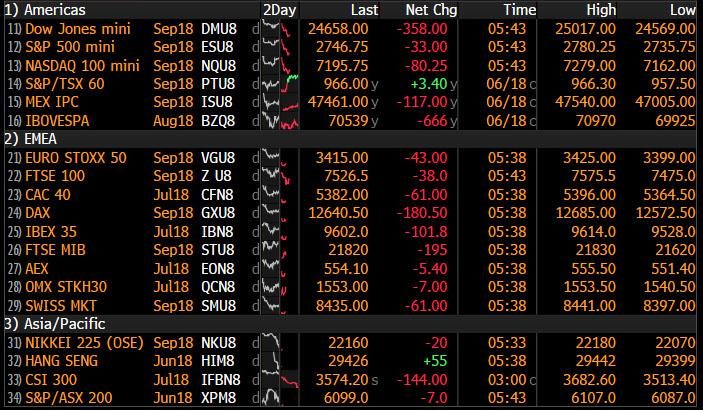
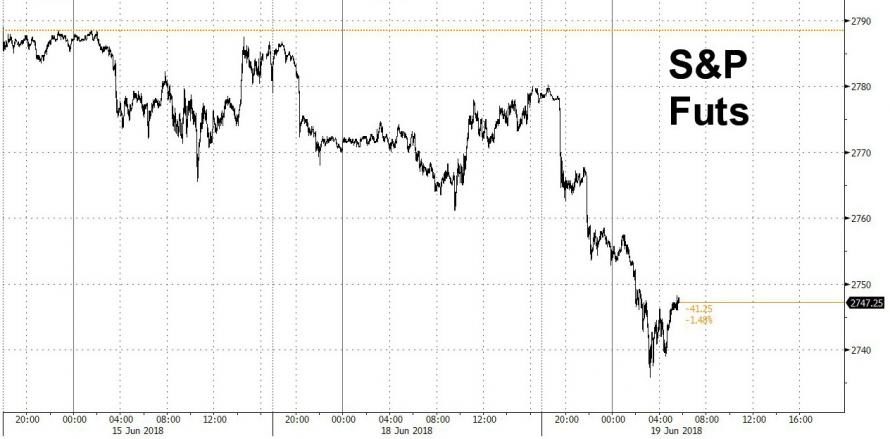
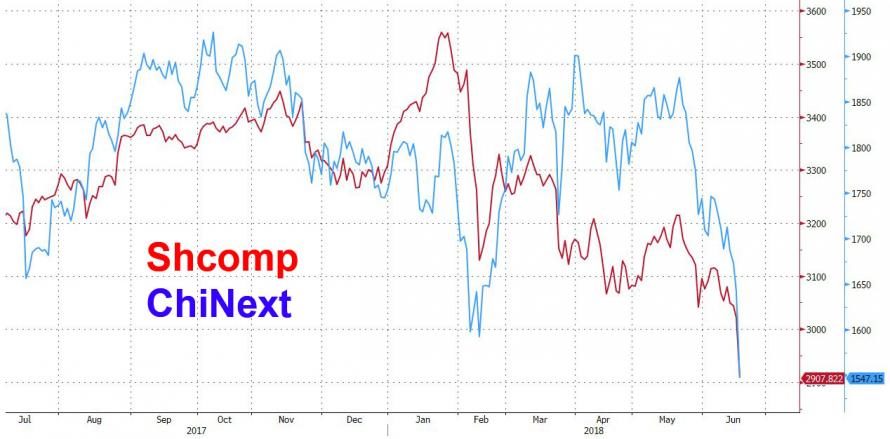
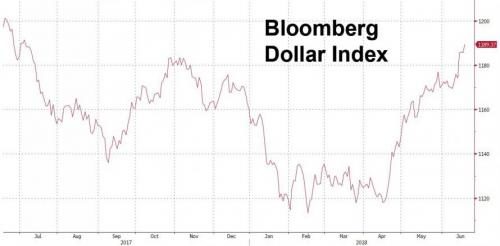
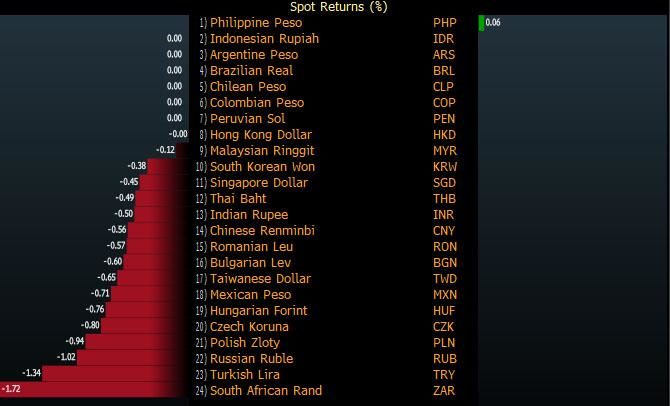
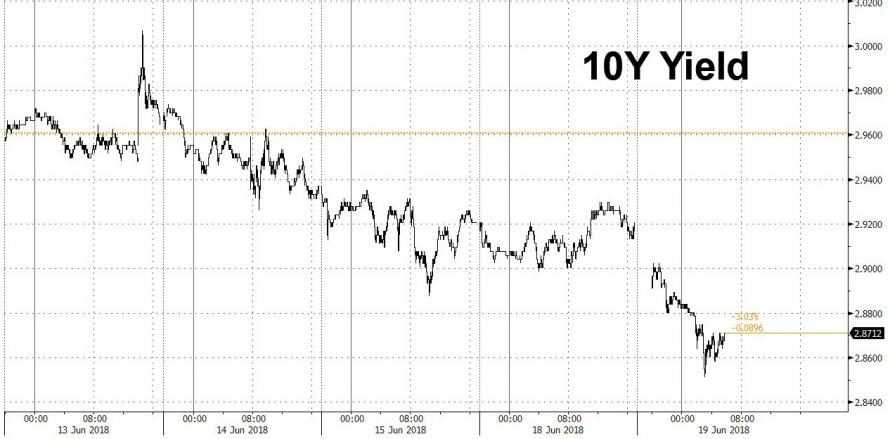
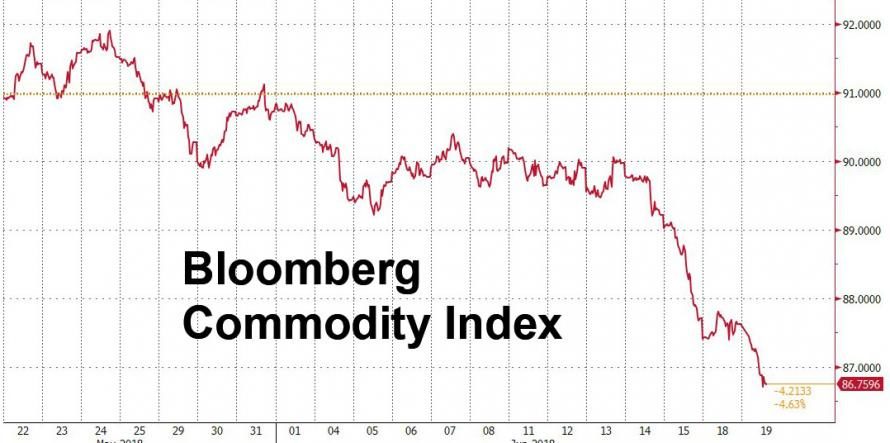



Comment: See also: Global markets tumble in response to escalating trade war between US and China